
Issue 22 | April 15, 2013 | Archive
News & Events
Banquet Bash!
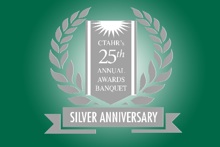 If you haven't yet registered for CTAHR’s 25th Annual Awards Banquet on May 3, now's the time to head over to the website and do it, so you don't miss the food, fun, friends, and chance to celebrate the college's best and brightest! Have a chance to applaud CTAHR's Outstanding Alumnus Dr. Wayne Iwaoka and Ka Lei Hano Award winner Dennis Teranishi, and enjoy the MC skills of Derek Kurisu and CTAHR student Shelley Wong. No-host cocktails start at 5:30; the program begins at 6:30. Don't miss it!
If you haven't yet registered for CTAHR’s 25th Annual Awards Banquet on May 3, now's the time to head over to the website and do it, so you don't miss the food, fun, friends, and chance to celebrate the college's best and brightest! Have a chance to applaud CTAHR's Outstanding Alumnus Dr. Wayne Iwaoka and Ka Lei Hano Award winner Dennis Teranishi, and enjoy the MC skills of Derek Kurisu and CTAHR student Shelley Wong. No-host cocktails start at 5:30; the program begins at 6:30. Don't miss it!
Help on the Road
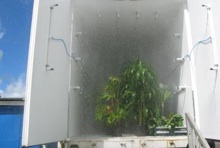 LIFE and Risk Management Hawaii have two installments of their very popular farmer education “road show” coming up: On April 19, there’s the Floriculture and Nursery Pest Control Field Day, which will tell all about management strategies for thrips, snow scale, ants, and more, and will also discuss the pest-abatement hot shower treatment for ornamentals. The field day is 1:30 to 3:30 p.m. at the Cal-Hawaii Foliage Growers in Keaau; to RSVP, call Andrew at (808) 981-5199 or email kawabataa@ctahr.hawaii.edu. And on Saturday, April 27, you can find out about fruit flies, banana moths, and Korean Natural Farming at the Orchard Growers Field Day—how to control the first two and how to harness the unique and ecologically conscious principles of the third. This is a great opportunity to learn more about two major pests and a major breakthrough! It’s 8:15 a.m. to 4:30 p.m at CTAHR’s Kona Research Station; call Gina at (808) 322-4892 or email ginab@hawaii.edu to reserve your spot.
LIFE and Risk Management Hawaii have two installments of their very popular farmer education “road show” coming up: On April 19, there’s the Floriculture and Nursery Pest Control Field Day, which will tell all about management strategies for thrips, snow scale, ants, and more, and will also discuss the pest-abatement hot shower treatment for ornamentals. The field day is 1:30 to 3:30 p.m. at the Cal-Hawaii Foliage Growers in Keaau; to RSVP, call Andrew at (808) 981-5199 or email kawabataa@ctahr.hawaii.edu. And on Saturday, April 27, you can find out about fruit flies, banana moths, and Korean Natural Farming at the Orchard Growers Field Day—how to control the first two and how to harness the unique and ecologically conscious principles of the third. This is a great opportunity to learn more about two major pests and a major breakthrough! It’s 8:15 a.m. to 4:30 p.m at CTAHR’s Kona Research Station; call Gina at (808) 322-4892 or email ginab@hawaii.edu to reserve your spot.
Leading Ladies of Leadership
 The College was well aware that Sylvia Yuen, former
Interim Dean of CTAHR, was outstanding. It seems clear that the YWCA of O‘ahu agrees, as they’ve selected her as one of four to be honored at their 2013 LeaderLuncheon on
Wednesday, June 19, along with a local artist, a public health educator and
lawyer, and the CEO of Kamehameha Schools. Register now to attend the
luncheon, where you can support and applaud her as she continues to demonstrate
her commitment to furthering community members’ well-being
throughout the state, and be able to say you knew her when!
The College was well aware that Sylvia Yuen, former
Interim Dean of CTAHR, was outstanding. It seems clear that the YWCA of O‘ahu agrees, as they’ve selected her as one of four to be honored at their 2013 LeaderLuncheon on
Wednesday, June 19, along with a local artist, a public health educator and
lawyer, and the CEO of Kamehameha Schools. Register now to attend the
luncheon, where you can support and applaud her as she continues to demonstrate
her commitment to furthering community members’ well-being
throughout the state, and be able to say you knew her when!
Grants & Awards
CTAHR Teaches How to Do It
 Congratulations
to CTAHR faculty for winning the top two teaching awards at UH-Manoa. Maria
Stewart (HNFAS) won the 2013 Frances Davis Award for Excellence in
Undergraduate Teaching, and Creighton Litton (NREM) won the 2013 Board of
Regents’ Excellence in Teaching Award! The college is honored to have two such
pedagogical superstars in its midst!
Congratulations
to CTAHR faculty for winning the top two teaching awards at UH-Manoa. Maria
Stewart (HNFAS) won the 2013 Frances Davis Award for Excellence in
Undergraduate Teaching, and Creighton Litton (NREM) won the 2013 Board of
Regents’ Excellence in Teaching Award! The college is honored to have two such
pedagogical superstars in its midst!
Spotlight on Our Community
Got Nutrient Info?
 The
“Got Nutrients?” website project created and written by Joannie Dobbs and Alan
Titchenal (both HNFAS) is heading into its fifth year of sending out “Daily
Tips” on nutrition, fitness, and health, with over 1,500 tips archived on the
project website. Now there’s a new public service announcement video for the website showing on television. The PSA
targets the older generation, but the tips are beneficial to all ages—and you
can sign up at the website to get them every day in your email. And with the
large and growing number of daily tips linked to both popular articles and
research abstracts, keyword searches of the website can provide a large number
of links to related content of interest. Check it out—good nutrition benefits
everybody!
The
“Got Nutrients?” website project created and written by Joannie Dobbs and Alan
Titchenal (both HNFAS) is heading into its fifth year of sending out “Daily
Tips” on nutrition, fitness, and health, with over 1,500 tips archived on the
project website. Now there’s a new public service announcement video for the website showing on television. The PSA
targets the older generation, but the tips are beneficial to all ages—and you
can sign up at the website to get them every day in your email. And with the
large and growing number of daily tips linked to both popular articles and
research abstracts, keyword searches of the website can provide a large number
of links to related content of interest. Check it out—good nutrition benefits
everybody!
Let Them Eat Fish
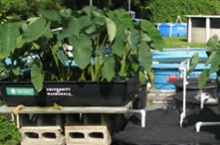 As part
of their series on “Feeding Ourselves: Hawai‘i’s Food Future,” Hawai‘i Public
Radio recently did a segment on aquaponics that highlighted the important work Clyde Tamaru (MBBE)
and CTAHR are doing both within the college and in partnership with community
organizations such as God’s Country Waimanalo. As Clyde points out, urban
gardens are going to be very important components in the state’s future food
security, and aquaponics is a great way to make the most of small amounts of
space.
As part
of their series on “Feeding Ourselves: Hawai‘i’s Food Future,” Hawai‘i Public
Radio recently did a segment on aquaponics that highlighted the important work Clyde Tamaru (MBBE)
and CTAHR are doing both within the college and in partnership with community
organizations such as God’s Country Waimanalo. As Clyde points out, urban
gardens are going to be very important components in the state’s future food
security, and aquaponics is a great way to make the most of small amounts of
space.
Ag at the Legislature
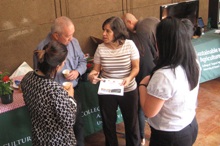 This
year’s Ag Day at the State Capitol, co-sponsored by Senator Nishihara and
Representative Wooley, brought Hawai‘i’s food and agriculture industries
together in an impressive display of unity. CTAHR was amongst over 40
exhibitors at this year’s event. The college’s UH Honeybee Project (including Ethel Villalobos, PEPS, pictured), Sustainable
and Organic Agriculture Program, Master Gardeners Program, and Aquaculture Hub
were on hand to answer questions from legislators and their staff. They even
ran into CTAHR alumnus Tyler Jones, who’s now with the Hawaii Agriculture
Research Center.
This
year’s Ag Day at the State Capitol, co-sponsored by Senator Nishihara and
Representative Wooley, brought Hawai‘i’s food and agriculture industries
together in an impressive display of unity. CTAHR was amongst over 40
exhibitors at this year’s event. The college’s UH Honeybee Project (including Ethel Villalobos, PEPS, pictured), Sustainable
and Organic Agriculture Program, Master Gardeners Program, and Aquaculture Hub
were on hand to answer questions from legislators and their staff. They even
ran into CTAHR alumnus Tyler Jones, who’s now with the Hawaii Agriculture
Research Center.
Moths to the Rescue
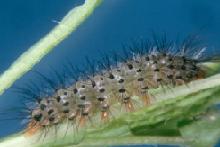 CTAHR is featured, and Mark
Thorne (HNFAS) quoted, in a recent
Maui News article about the fireweed
moths that have been released on the Big
Island and will soon be released on Maui. The invasive fireweed, which has been crowding out
forage for cattle and can even be toxic to them, is the favored food of this
moth’s larvae—so much so that researchers have confirmed that the introduced insect
won’t eat anything else but this noxious plant. And we say they’re welcome to it!
CTAHR is featured, and Mark
Thorne (HNFAS) quoted, in a recent
Maui News article about the fireweed
moths that have been released on the Big
Island and will soon be released on Maui. The invasive fireweed, which has been crowding out
forage for cattle and can even be toxic to them, is the favored food of this
moth’s larvae—so much so that researchers have confirmed that the introduced insect
won’t eat anything else but this noxious plant. And we say they’re welcome to it!
Be Aware, Be Very Aware
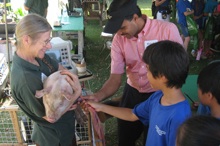 The Urban
Garden Center brought together more than 600 elementary students and their
teachers with exhibitors from CTAHR and other ag-related agencies and
businesses at the 2013 O‘ahu Agriculture and Environmental Awareness Day hosted
by the O‘ahu Cooperative Extension Office and Office of Academic and Student
Affairs. Also on hand were news crews from KITV and
Hawaii News Now. Students got to see an aquaponics display and experience the
heartbeat of a baby pig (pictured here with Halina Zaleski, HNFAS) with ultrasound; other crowd-pleasing exhibits included
compost-creating worms, invasive species-sniffing beagles, and an artificial
cow with which to demonstrate artificial insemination. The annual event serves
a two-fold purpose: To create a greater awareness and understanding of
agriculture and the environment among today’s students, teachers, and the
general public; and to introduce students to career opportunities in
agriculture and environmental studies throughout the state. The
Urban Garden Center’s Second Saturday event featured
many of the same exhibitors on the following day.
Thank you to the UGC staff and volunteers; CTAHR faculty, students, and staff; community members and company representatives; and Golden
Key, for volunteering for this event. Funding support was provided by USDA-NIFA through
the Agribusiness Education,
Training and Incubation (AETI) Program.
The Urban
Garden Center brought together more than 600 elementary students and their
teachers with exhibitors from CTAHR and other ag-related agencies and
businesses at the 2013 O‘ahu Agriculture and Environmental Awareness Day hosted
by the O‘ahu Cooperative Extension Office and Office of Academic and Student
Affairs. Also on hand were news crews from KITV and
Hawaii News Now. Students got to see an aquaponics display and experience the
heartbeat of a baby pig (pictured here with Halina Zaleski, HNFAS) with ultrasound; other crowd-pleasing exhibits included
compost-creating worms, invasive species-sniffing beagles, and an artificial
cow with which to demonstrate artificial insemination. The annual event serves
a two-fold purpose: To create a greater awareness and understanding of
agriculture and the environment among today’s students, teachers, and the
general public; and to introduce students to career opportunities in
agriculture and environmental studies throughout the state. The
Urban Garden Center’s Second Saturday event featured
many of the same exhibitors on the following day.
Thank you to the UGC staff and volunteers; CTAHR faculty, students, and staff; community members and company representatives; and Golden
Key, for volunteering for this event. Funding support was provided by USDA-NIFA through
the Agribusiness Education,
Training and Incubation (AETI) Program.
Cone of Power
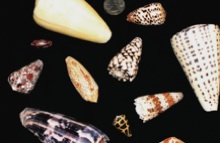 Jon-Paul
Bingham’s (MBBE) research on cone snail toxins was recently featured in
an ABC news story. Jon-Paul explains that the cone snail’s venom, though
potentially fatal to humans, has one positive side effect: its victims don’t
feel any pain. Isolating the chemical compound that makes this possible has led
to the creation of a pain-relieving drug a thousand times stronger than
morphine…that isn’t addictive. Jon-Paul points out that while some drugs are
like skeleton keys, which may have both the desired effect and a number of
unintended and even deleterious side effects, compounds made from cone snail
venom are targeted and specific. This is also what
makes them so deadly…something those in Jon-Paul’s lab must never forget.
Jon-Paul
Bingham’s (MBBE) research on cone snail toxins was recently featured in
an ABC news story. Jon-Paul explains that the cone snail’s venom, though
potentially fatal to humans, has one positive side effect: its victims don’t
feel any pain. Isolating the chemical compound that makes this possible has led
to the creation of a pain-relieving drug a thousand times stronger than
morphine…that isn’t addictive. Jon-Paul points out that while some drugs are
like skeleton keys, which may have both the desired effect and a number of
unintended and even deleterious side effects, compounds made from cone snail
venom are targeted and specific. This is also what
makes them so deadly…something those in Jon-Paul’s lab must never forget.
What’s Eating the Trees?
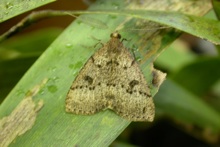 William
Haines (PEPS) is keeping watch over the koa forests. In January 2013, a
helicopter flyover above Hilo and the Hamakua coast on the Big Island showed
that 25,000 acres of koa trees had been defoliated, and the area is still
increasing in size. Koa is the most important native hardwood for agroforestry,
conservation, and restoration, and it’s also the preferred food of caterpillars
of the endemic koa looper moth. Koa loopers experience natural population
outbreaks, which have been documented since the late 1800s; these outbreaks
produce mass defoliations, while native birds have been reported flocking in
large numbers to feed on the abundant caterpillars. Past outbreaks indicate
that most trees recover from defoliation to resprout leaves within a year, but
mortality rates of 35% have been recorded in unhealthy forests. And this is the
largest outbreak of koa looper ever seen. No one knows what triggers outbreaks,
or how they are brought back under control. William Haines has been monitoring
caterpillar populations on the ground, in cooperation with the Hawaii
Department of Land and Natural Resources and local US Forest Service staff,
with the goal of tracking the outbreak and learning more about the biology of
the caterpillar and its native and non-native predators and parasitoids, as
well as monitoring the impacts on and recovery of koa trees.
Check out more of his photos of the looper and the damage it causes.
William
Haines (PEPS) is keeping watch over the koa forests. In January 2013, a
helicopter flyover above Hilo and the Hamakua coast on the Big Island showed
that 25,000 acres of koa trees had been defoliated, and the area is still
increasing in size. Koa is the most important native hardwood for agroforestry,
conservation, and restoration, and it’s also the preferred food of caterpillars
of the endemic koa looper moth. Koa loopers experience natural population
outbreaks, which have been documented since the late 1800s; these outbreaks
produce mass defoliations, while native birds have been reported flocking in
large numbers to feed on the abundant caterpillars. Past outbreaks indicate
that most trees recover from defoliation to resprout leaves within a year, but
mortality rates of 35% have been recorded in unhealthy forests. And this is the
largest outbreak of koa looper ever seen. No one knows what triggers outbreaks,
or how they are brought back under control. William Haines has been monitoring
caterpillar populations on the ground, in cooperation with the Hawaii
Department of Land and Natural Resources and local US Forest Service staff,
with the goal of tracking the outbreak and learning more about the biology of
the caterpillar and its native and non-native predators and parasitoids, as
well as monitoring the impacts on and recovery of koa trees.
Check out more of his photos of the looper and the damage it causes.
An Ocean of Trash
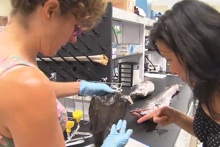 Lesley
Jantz, a 2012 NREM alumna who now works as a fishery biologist with NMFS-NOAA,
did her thesis work on the ingestion of marine debris by longnose lancetfish in the
North Pacific Ocean with committee members Greg Bruland and Chris Lepczyck. She
was recently interviewed by CNN
concerning this study for a news story on Japan tsunami
marine debris in Hawai‘i at the 2nd anniversary of the great East Japan
earthquake and tsunami. She dissected several stomachs from longnose
lancetfish, bigeye tuna, and yellowfin tuna, pulling out pieces of plastic up
to a foot square. Almost half of the 24 lancetfish analyzed had ingested
plastic, along with two of the tuna. Eating plastic isn’t a problem only for
the fish, Lesley explained; chemicals from the plastic may get into the flesh
of the lancetfish and into the tuna that eat them, which then poses a risk for
humans consuming the tuna. Though he’s not identified by name, work done on ingestion
of plastics by NREM student Andrew Titmus, who works in the HPU lab, is also
discussed in the interview.
Lesley
Jantz, a 2012 NREM alumna who now works as a fishery biologist with NMFS-NOAA,
did her thesis work on the ingestion of marine debris by longnose lancetfish in the
North Pacific Ocean with committee members Greg Bruland and Chris Lepczyck. She
was recently interviewed by CNN
concerning this study for a news story on Japan tsunami
marine debris in Hawai‘i at the 2nd anniversary of the great East Japan
earthquake and tsunami. She dissected several stomachs from longnose
lancetfish, bigeye tuna, and yellowfin tuna, pulling out pieces of plastic up
to a foot square. Almost half of the 24 lancetfish analyzed had ingested
plastic, along with two of the tuna. Eating plastic isn’t a problem only for
the fish, Lesley explained; chemicals from the plastic may get into the flesh
of the lancetfish and into the tuna that eat them, which then poses a risk for
humans consuming the tuna. Though he’s not identified by name, work done on ingestion
of plastics by NREM student Andrew Titmus, who works in the HPU lab, is also
discussed in the interview.
Cool Kulanui
 Did you know that up to 40 percent of some agricultural
crops can’t be sold? The fruits and vegetables might be too small, too green,
too ripe, too scabby, or just not shaped appealingly. These are the seconds, or
culls. And the processing of value-added foods also often creates edible
byproducts that may not get used. This is where Kulanui comes in. After Wayne
Iwaoka, Stuart Nakamoto, and Alvin Huang (all HNFAS) got the idea to challenge
students to come up with their own value-added products using byproducts and
culls, Kulanui was born. Now the company markets foods made by CTAHR and other
UH students out of these previously unused products, as well as beauty products
made from local beeswax. There’s a new UH News video about Kulanui,
which also features CTAHR alumna Jennifer Shido (pictured), Kulanui’s enthusiastic project
manager. Kulanui products are available in most campus bookstores and at all
Rainbowtique locations.
Did you know that up to 40 percent of some agricultural
crops can’t be sold? The fruits and vegetables might be too small, too green,
too ripe, too scabby, or just not shaped appealingly. These are the seconds, or
culls. And the processing of value-added foods also often creates edible
byproducts that may not get used. This is where Kulanui comes in. After Wayne
Iwaoka, Stuart Nakamoto, and Alvin Huang (all HNFAS) got the idea to challenge
students to come up with their own value-added products using byproducts and
culls, Kulanui was born. Now the company markets foods made by CTAHR and other
UH students out of these previously unused products, as well as beauty products
made from local beeswax. There’s a new UH News video about Kulanui,
which also features CTAHR alumna Jennifer Shido (pictured), Kulanui’s enthusiastic project
manager. Kulanui products are available in most campus bookstores and at all
Rainbowtique locations.